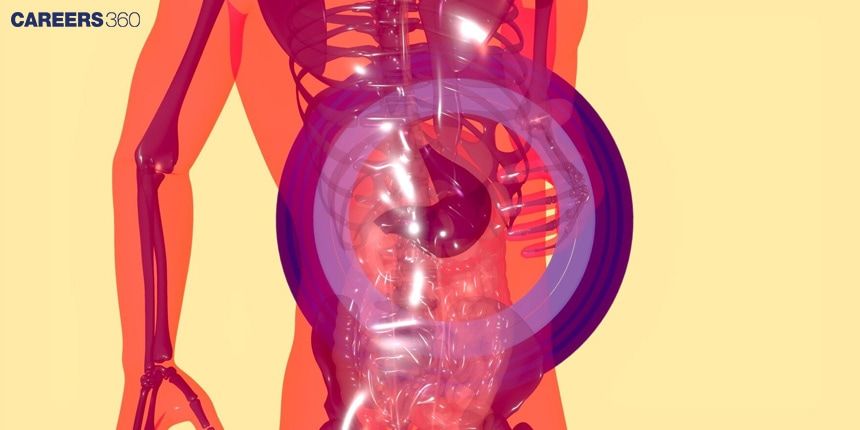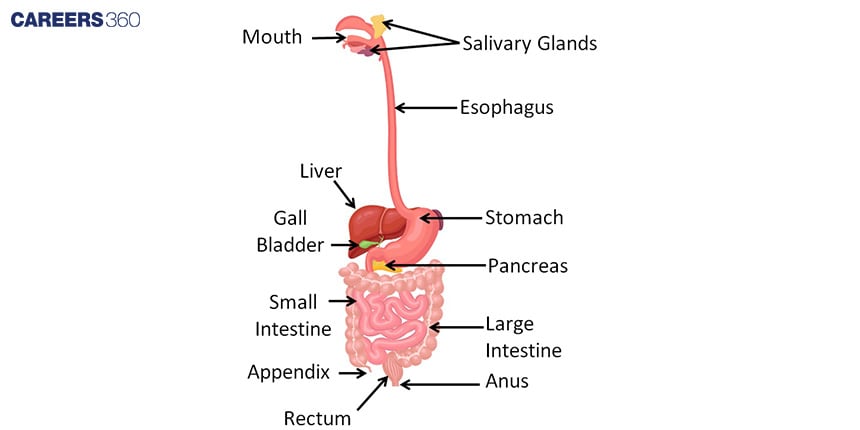Diagram Of Digestive System with Detailed Explanations
The digestive system is a complex organisation of organs responsible for breaking down food into smaller compounds that the body can absorb and use for energy, growth, and repair. It includes the mouth, oesophagus, stomach, intestines, and accessory organs like the liver and pancreas. In this article, the digestive system, key concepts and definitions, a diagram of the Human Digestive System, and parts of the Human Digestive System are discussed. Diagram of the Digestive System is a topic of the chapter Digestion and Absorption in Biology.
Don't Miss: Most scoring concepts for NEET | NEET papers with solutions
NEET 2025: Syllabus | PYQs | Crack NEET in 2 months - Study Plan
NEET Important PYQ & Solutions: Physics | Chemistry | Biology | NEET PYQ's (2015-24)
- What is the Digestive System?
- Key Concepts and Definitions
- Diagram of the Human Digestive System
- Parts of the Human Digestive System
- Different Aspects And Types

What is the Digestive System?
The human digestive system could be compared to a highly mechanized factory in which food is processed and turned into energy and nutrients. The process starts the moment you take a bite of food, breaking down complex substances into forms that are simple enough for your body to use.
Understanding how this system works may help you appreciate the wonders of human biology and should give you a better appreciation for the importance of proper nutrition to your health. The article deals with the anatomy, functions, and significance of the human digestive system, explaining parts and processes given their practical implication.
Key Concepts and Definitions
The human digestive system has two major divisions: the gastrointestinal tract, also known as the alimentary canal, and accessory organs. The alimentary canal is a muscular, elastic tube that measures about nine meters long and extends from the mouth to the anus. It is a continuous tube that starts at the mouth and ends at the anus, through which food goes and is subject to a series of mechanical and chemical procedures that prepare it for nutrient absorption.
Specifically, these segments are the mouth, pharynx, oesophagus, stomach, small intestine, large intestine, rectum, and anus, each of which carries out certain specialized activities potentiallyIdentical segments are the mouth, pharynx, oesophagus, stomach, small intestine, large intestine, rectum, and anus, each performing certain specialized activities crucial to digestion and the elimination of waste.
Also Read-
Diagram of the Human Digestive System
Parts of the Human Digestive System
The human digestive system is such a complex system of organs that all work in coordination to break down the ingested food for the needed nutrients that will provide fuel to our bodies. Major parts of this include the gastrointestinal tract and associated accessory organs like the tongue, liver, and pancreas. The parts work in cooperation to allow digestion and absorption of food.
It's a long tube from the mouth, where food is taken into the buccal cavity, all the way out to the anus. Otherwise known as through the pharynx, oesophagus, stomach, small intestine, large intestine, rectum, and anus, all these parts of this canal play different roles in digestion. The further along the gut the chyme travels, the more and more broken down the food gets.
These accessory organs of digestion secrete enzymes that help in digestion. For instance, the pancreas secretes digestive enzymes into the small intestine, while the liver secretes bile that emulsifies fat. Other enzymes and juices, which break grounding food components into forms already capable of being absorbed and used by the body, come from these parts.
Let us have a detailed look at the digestive system of the human body, along with its parts and functions:
Mouth:
Food is ingested into the mouth, where it undergoes mechanical and chemical digestion due to teeth and saliva, respectively. Saliva contains enzymes like amylase that break down carbohydrates initially.
Pharynx:
This part of the throat serves as the common passage for food and air since it directs the swallowed food into the oesophagus and forbids its entrance into the trachea, or windpipe.
Esophagus:
The muscular tube includes food from the pharynx down to the stomach, because of peristalsis, a rhythmic muscle contraction aiding in forwarding food along.
Stomach:
This sac-like organ churns and mixes food with gastric juices—mainly hydrochloric acid and pepsin, making it suitable for the digestion of proteins. Apart from this, the stomach also secretes mucus, which saves its lining from attack by acid.
Small Intestine:
Further divided into three parts, namely, duodenum, jejunum, and ileum; the small intestine is the area where maximum absorption of nutrients takes place. Villi and microvilli are small, finger-like projections lining the intestine that increase surface area, allowing the efficient absorption of nutrients into the blood.
Large Intestine:
It is also referred to as the colon. The primary functions of this organ include the absorption of water and electrolytes from undigested food matter to form solid waste, also called faeces, for elimination.
Rectum And Anus:
Stores faeces till they are expelled out through the anus during defecation.
Different Aspects And Types
Each portion of the gastrointestinal tract has an essential role in the processing of food and absorption of nutrients. The acidity in the stomach promotes digestion but excludes the entry of pathogens. On the other hand, the absorptive surface of the small intestine is maximized by its special structure, which once more reflects human physiology's efficiency and adaptability.
Also Read-
Frequently Asked Questions (FAQs)
The digestion of food in the digestive system entails both mechanical and chemical digestion. Mechanical digestion begins with chewing in the mouth and then continues in the stomach through churning and mixing food muscularly with the digestive juices. Chemical digestion refers to the action of enzymes and acids in the breakdown of complex molecules into simple forms for absorption in the body. It initiates in the mouth using saliva, where there are enzymes like amylase to begin the process of digestion in breaking down a carbohydrate. Afterwards, there will be additional digestion in the stomach and small intestine with varied enzymes responsible for protein and fat digestion.
Enzymes are biological catalysts that maintain the pace of chemical reactions in the body. They assist in the breakup of food during digestion. There are various types of enzymes needed for the breakdown of different nutrients: amylases, which break down carbohydrates into sugars; proteases, which break down proteins into amino acids; and lipases, which break down fats into fatty acids and glycerol. Three types of enzymes along the digestive tract digest food and make absorption of the broken products perfect.
Mainly, fibre is essential for digestive health since it provides bulk to stool and hence helps in regular bowel movement, preventing constipation. Soluble fibre partially dissolves in water, taking a gel-like form that helps in moderating the assimilation of sugar into the blood and reducing the level of cholesterol. Insoluble fibre provides bulk to stool and helps in its passage through the guts, providing health to the guts and hence preventing digestive disorders like diverticulosis.
Common digestive disorders include:
Gastroesophageal reflux disease (GERD): Heartburn, symptoms related to the regurgitation of stomach acid, and trouble swallowing.
Irritable bowel syndrome (IBS): The predominant symptoms always include abdominal pain; next in frequency are bloating, diarrhoea, and constipation.
Crohn's disease and ulcerative colitis: Inflammatory bowel diseases characterized by abdominal pain, diarrhoea often bloody, loss of weight, and fatigue.
Celiac disease: A disorder in which the ingestion of gluten induces an immune-mediated response, causing damage to the small intestine, diarrhoea, bloating, fatigue, and other symptoms.
The food we eat has an enormous influence on how our digestive systems work and thus on the health of our whole bodies. A well-rounded diet delivers all the needed building blocks for optimal digestion, complete with colourful fruits and veggies, whole grains, lean proteins, and healthy fats. Fibre keeps one's bowel regular and promotes good bacteria in the gut. On the other hand, diets that are highly processed and full of saturated fats and added sugars have low fibre, leading to underactive digestion: constipation, bloating, and chronic inflammation. A varied and well-balanced diet gives rise to good overall digestive health and bridges towards higher quality living.
Also Read
30 Nov'24 03:25 PM
26 Nov'24 05:38 PM
25 Nov'24 06:43 PM
25 Nov'24 05:45 PM
25 Nov'24 04:48 PM
25 Nov'24 03:52 PM
23 Nov'24 04:30 PM
23 Nov'24 10:03 AM
